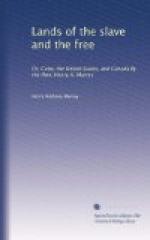There is an old ditch in the neighbourhood, which goes by the name of Lord Dunmore’s Ditch. The history which my informant gave me thereof is absurd enough, and there is a negro of the name of Isaac still living who remembers all the circumstances. It appears that Lord Dunmore, having found fault with an Irish labourer for not doing sufficient work, Paddy replied, “’Faith, if ’twas yer ’onnur that had the shpade in yer hand, maybe one-half would satisfy yer ’onnur.” The Governor, who happened to be a man of iron frame, and not at all averse to a joke, immediately took up Paddy’s challenge, and replied, “Paddy, I’ll work four hours against you in a ditch for a month’s wages.” The combatants set to work the following morning, and at the end of four hours Paddy was obliged to confess himself beaten, and the result of my grandfather’s labours goes by the name of Lord Dunmore’s Ditch to this day.
The only parts of the old palace still standing are the two wings, one of which is now the parsonage, and the other a school, which is kept by an Englishman, educated at one of our universities, and living here for his health. This place is both a well-chosen and a favourite locality for schools, being situated upon a high plateau of land, with James River on one side and York River on the other; consequently, the air is peculiarly healthy and pure.
The most imposing, if not the most useful, of the scholastic establishments is the college, which was founded by William and Mary in the year 1692. It contains a very fair library of old books, but comparatively few additions appear to have been made in latter years. The building bears every internal mark of neglect and dilapidation, defaced walls, broken plaster, &c. Upon entering the lecture-room, a quantity of eighteen-inch square boxes full of moisture suggest the idea of a rainy day and a roofless chamber. Be not deceived: these are merely receptacles for the discharge of the students’ ’bacco juice; and the surrounding floor gives painful demonstration that their free spirits scorn the trammels of eighteen-inch boundaries, however profusely supplied. From what causes I cannot say, but the college has been all but deserted until lately. The present authorities are striving to infuse into it a little vitality of usefulness. With these simple facts before me, it was amusing to read, in an American gazetteer of the day, that the college “is at present in a flourishing condition.”
In front of the college there is an enclosed green, and in the centre a statue, erected in honour of one of the old royal governors, Berkeley, Lord Bowtetort. Whether from a desire to exhibit their anti-aristocratic sentiments, or from innate Vandalism, or from a childish wish to exhibit independence by doing mischief, the said statue is the pistol-mark for the students, who have exhibited their skill as marksmen by its total mutilation, in spite of all remonstrances from the authorities. The college was formerly surrounded




